Mark Mylod‘s pitch-black satire The Menu is a devilishly fun poke at the high-end restaurant industry and the foodies who frequent such establishments. The film stars Ralph Fiennes as Chef Slowik, who regularly invites 12 well-to-do food enthusiasts to his remote island restaurant of Hawthorne for a mere $1,200 a head. But he’s not just preparing a meal for them, he’s preparing an experience.
The Menu is set over the course of one particularly eventful night which the chef has catered for a very exclusive and specific guest list, who are joined by an uninvited intruder, played by Anya Taylor-Joy.
The film was designed by ADG Award-winning Production Designer Ethan Tobman, who has spoken to Below the Line a few times in the past about previous projects, such as Free Guy and Room. The Menu allowed him to pull out all the stops while designing and building Chef Slowik’s Hawthorne, where most of the film takes place. He also worked closely with chefs and food stylists to ensure that every plate that is served in Slowik’s dining room looked as fantastic as the restaurant itself.
Below the Line recently spoke with Tobman over the phone for another fascinating look into his process, and how he managed to make The Menu look so delicious.
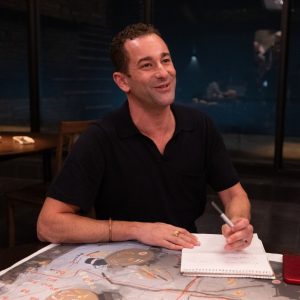
Below the Line: This film is very different from a lot of other stuff you’ve done, no?
Ethan Tobman: I think that’s part of why I was attracted to it and will always try to pursue projects that are [as] different from each other as possible, because I find that really interesting — to look back on your work and not get pigeonholed.
I was in the middle of the miniseries Pam and Tommy when I got a call for this. I’ve always been obsessed with food culture. When I started as a young filmmaker, and I couldn’t get work in film, I worked in restaurants. I very nearly fell into that as a career, working in the kitchen. It reminded me so much of filmmaking, and it primed me for filmmaking. It’s 12-hour shifts, transient instant families. It’s [a] really ephemeral, super-specific environment you create that people pay for to escape from their lives for a couple hours.
I was always looking for a project that combined this world with that, and when I got the script, I thought, “Okay, I’m not going to reference other movies. For this, I’m not going to look at Babette’s Feast or The Cook, the Thief, the Wife and Her Lover, and all the movies about food [that] I’ve always loved. I want to reference the artwork and photojournalism that inspired me to become a foodie in the first place.”
I looked at Francis Bacon‘s famous Pope drawings, of the Pope being burned while the Beast stays behind him. The John Curran paintings of excessive dining in really twisted, high-end society, and the Dutch masters’ paintings of dead pheasants and dead foxes, [which] are really creepy.
I walked into the meeting and showed Mark Mylod this, and immediately, he was just like, ‘Yes, this is what I wanted to talk about. I want to talk about how the restaurant makes you feel, how uncomfortable it is, and what food says about our culture.’ And that was the reason to make the movie, and he hired me in that first meeting because I think we both realized we would push each other to make our ideas better, and we really got a kick out of each other.
BTL: The Hawthorne restaurant is as impressive as the dishes cooked there. I remember that the last time we spoke, you said it was a huge build, so did you have to find an island where you could actually build everything on it, like the restaurant and Chef’s cottage?
Tobman: When I got the job for this movie, we were going to shoot in Scotland, and I thought we would be embracing the landscape and creating certain things inside of it. As luck would have it, COVID made shooting in Europe prohibitive, and we had to pivot to Savannah, Georgia. Every single tree and bush and spice field had to be brought in because we didn’t want it to look like Southern marshlands. When it was all said and done, and we looked back at the movie, I think I created more frames than I did on Free Guy for The Menu; everything is created. It’s a whole world that needed to be designed, which we had a great time doing. It was like taking the patrons down Alice’s rabbit hole, where each place they go to gets just a little bit more surreal and severe.
[Regarding] the restaurant, in particular, Mark told me early in our meetings [that] he loved the idea that every material in the restaurant would be harvested from the island’s ecosystem, because Slowik is obsessed with nature’s perfection. I was really inspired by that and sort of said, ‘Okay, what if we take the materials, and we treat them the way a chef would treat them? We’ll blanch them and char them and bleach them and dry them,’ and I just found that so interesting. I’ve never approached architecture that way before, and I also really liked the idea that Chef is inspired by nature’s perfectionism, but he’s also haunted by it. As a result, he’s actually destroying it. He’s imposing his perfectionism on nature and twisting it and turning it into something that isn’t nature anymore at all.
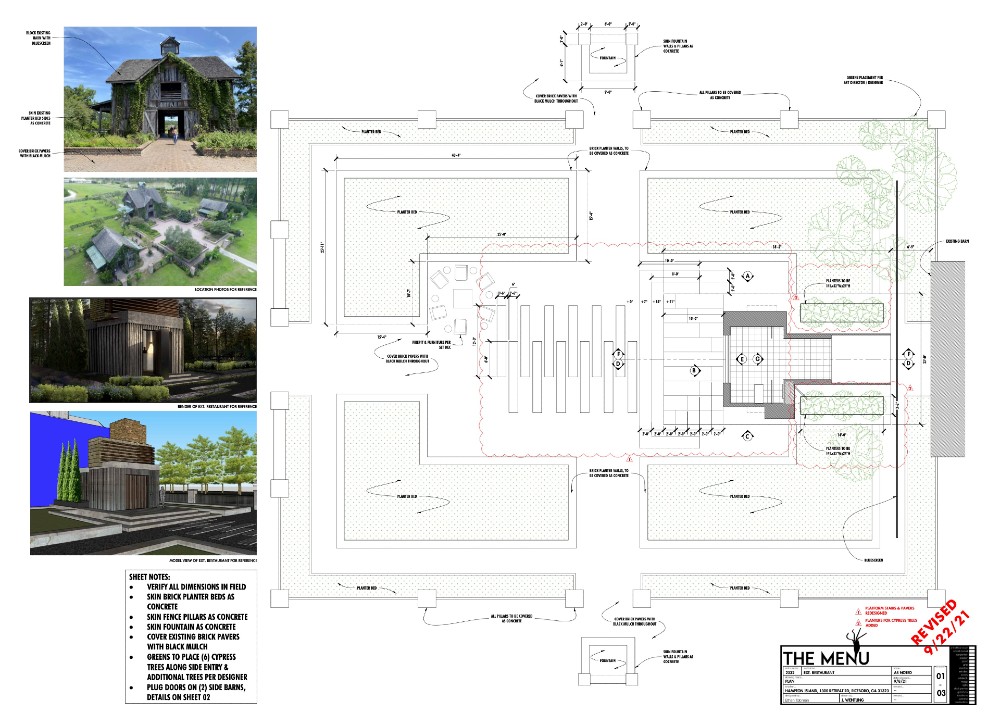
I love the idea of the kitchen having an ecclesiastical geometry — there’s a cross buried in the back wall — [as Chef] is built on a slightly higher perch. He’s essentially sermonizing from a pulpit and the junior chefs are genuflecting when he delivers each course. I found that really creepy and really interesting, because food culture and religion are so similar — the chefs are deities. I really love the idea of designing every — what’s called a “vessel” — for the food. The plate in high-end dining actually refers to the food that is on the plate, and the plate is a vessel. The food goes on to a vessel, so we needed to design all of those vessels. It was something that Chef [Dominique] Crenn and I began talking about months in advance. I wanted every vessel to also look like it was cleaved from the island’s ecosystem.
Chef Crenn and I — it’s a very interesting story how we started working together and where that relationship went. Essentially, we wanted to hire a three-star Michelin chef who would give us credibility in that world, but we also really wanted to hire a woman, because it’s such a misogynistic, male-dominated culture in high-end cuisine. We really wanted to say a little “fuck you” to that establishment, so Chef Crenn was at the top of my list, and Betsy Koch‘s list, our producer, and the writers’ list, so we thought, ‘Let’s go for it. She’s probably never gonna want to do it.’ She [then] said, “Yes,” and we started working together.
Chef Crenn and her pastry chef, Juan Contreras, we started working very, very close together, her and I, designing the dishes, designing the vessels, designing the courses. It became clear that we weren’t totally seeing eye to eye at first. They come from a synthesis of food and texture and visuals, and, of course, two out of those three things you can’t experience while watching the movie. I was trying to guide them to something that would look good on the set, look good on camera and be appropriate for our character.
At first, we weren’t vibing, and then about two weeks in, it just started clicking, and Chef said, ‘Now, we’re dancing together,’ and the dishes started really coming to life. I would suggest something, they would suggest something. I started informing some of the food, they would start informing the design of the kitchen. It just started working, and when Chef Crenn walked onto the set, she said, ‘I want you to design my restaurant.’ And I thought, “she’s kidding. That’s never going to happen.” And six months later, she called me and said, ‘Okay, are you ready?’ Right now, I’m redesigning her restaurant, so it’s a real art-imitates-life-imitates-art story.
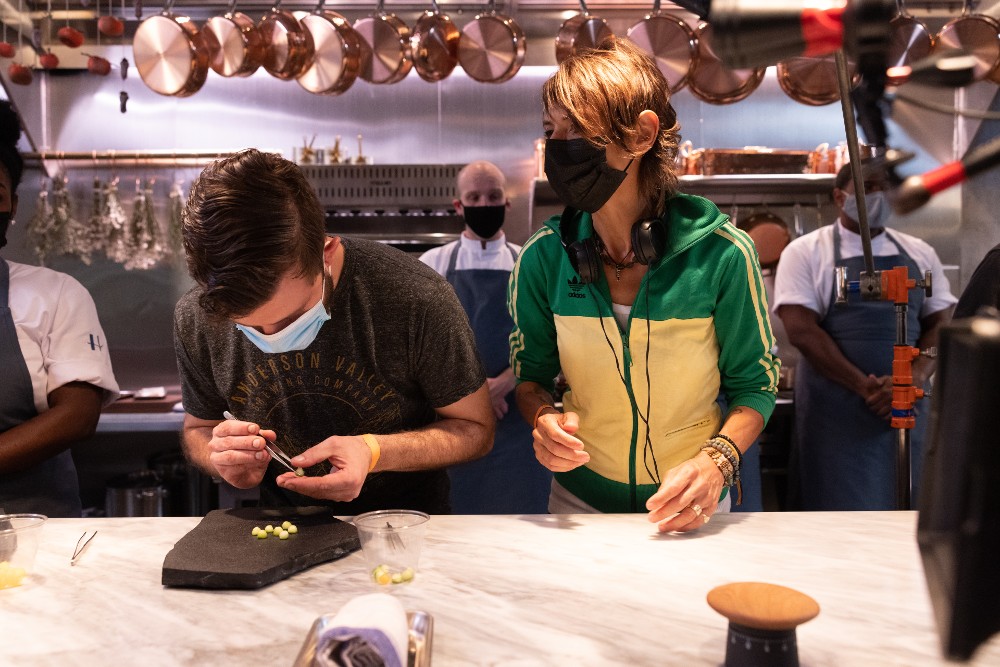
BTL: Were the interiors of Hawthorne all on a stage somewhere?
Tobman: Every interior is built on the stage. The exterior, we built a facade and 30 feet of the interior hallway inside that swivel door, in order to tie them together, so that we could see them from the exterior walking into the restaurant and going a fair distance before hitting a blue screen. Then, on the stage, we built the same interior and hallway with 30 feet of grass outside the doorway, so that you could tie them together. I will very happily send you concept art and set photos to help explain that process because I find it really interesting to see how we figured that out. We have actual 3D fly-throughs, like animatics and stuff. I just always find that so dynamic for filmmakers to look at.
BTL: We do see the interior of Chef’s house, and it looks like he has almost an identical kitchen and dining room in there. Did you do most of the shoot and then redress the set to show the second empty dining room?
Tobman: What we did was, we tried to figure out a way for production to leave and go do a week of work outside, and then we painted every wall. We plugged the hallways. We brought in dramatically different lighting, because there’s nothing that changes a room faster, and a different view outside the windows, and just a little bit of domestic touches. The idea is that he’s obsessed so much with the restaurant that he’s built that he lives inside of it. We had to really rush to do, let’s say, two weeks’ worth of work in one week — changing every wall surface, redecorating, and changing the lighting.
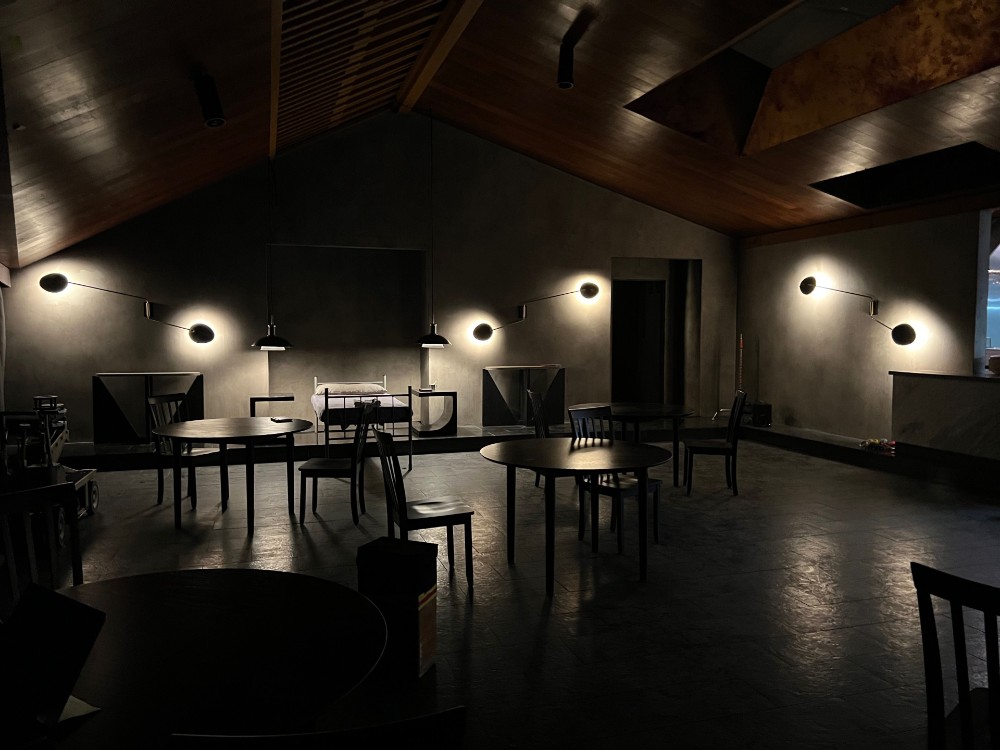
BTL: I love the set design inside the main Hawthorne restaurant, especially the spice wall we see in the background, which seems to be filled with so many random things.
Tobman: The spice wall… it’s funny you [mention] that; I’m glad you mentioned that. There are many details here that are little nods to famous chefs. So, El Bulli, one of the greatest institutions of all time, this restaurant in Spain, had a spice wall similar to that, and [it] is no longer — that restaurant has closed. I really wanted to reference that obsessive-compulsive chef’s cataloging of spices in our set. It’s a little homage to Ferran [Adrià], the chef/creator of that restaurant. There are other nods to other chefs as well, that I hope both chefs and high-end foodies will recognize.
BTL: I definitely knew about El Bulli, because there was a documentary about it and Anthony Bourdain featured it on one of his shows. The “food porn” element is also a big part of the movie, so did you have a food stylist involved with designing those dishes?
Tobman: Sometimes, I feel like my job is to corral the most interesting people together and figure out how to get them to talk to each other, because they’re not used to seeing their talents in the ways that filmmaking usually requires them to. This was an extraordinary group of people [who] I worked really closely with, and Betsy Koch, our really brilliant producer, to think outside of the box, in [terms of our] approach.
Over here, we have Chef Crenn and her team of illustrious high-end food makers. Over here, we have this wonderful Food Stylist Kendall [Gensler], who comes from the filmmaking side of things, who had to figure out how to take their insanely temporary concoctions and make them last for 10 hours using non-food techniques. For example, the obvious one is, ice cream is made out of mashed potatoes, which Chef Crenn and her team would be mortified by, right? But then, you have to figure out how to film them, so Betsy had the brilliant idea of bringing David Gelb, the creator of Chef’s Table, on to shoot some of our dedicated food shots.
Because David is such a foodie himself, he also would have a little opinion about the best way to feature a sauce, lettuce, dry ice. So you have all of these brilliant artisans of a similar art [form], but [coming at it] from a different perspective, and you kind of have to corral them all together as a production designer and make it work for the story. That was fascinating to see them figuring out how to communicate with each other.
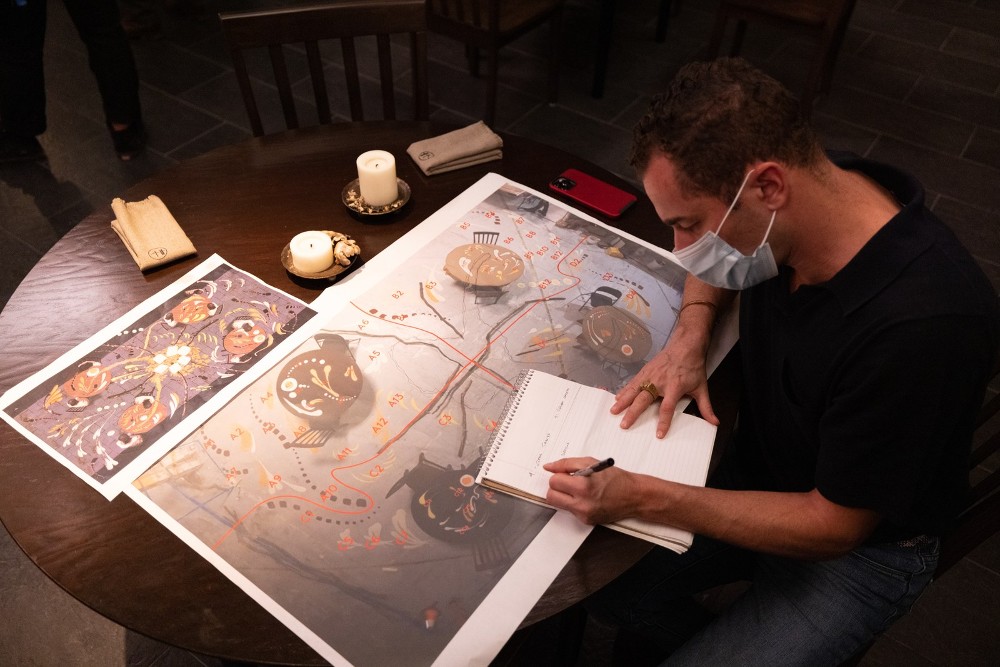
BTL: Was all of that food actually edible, and if so, how’d you figure out who got the leftovers?
Tobman: Look, it’s 100 percent edible because it needs to be eaten in real time on set. It also needs to survive 12 hours of heavy lighting. The purpose of it was not to be as delicious as what Chef Crenn would prepare at her restaurant or what Chef Slowik would have prepared on his menu. It’s to look delicious, but it is absolutely edible. To the best of our abilities, we tried to make it good. We tasted everything, but the goal was, ultimately, to make it as edible as possible [and] as beautiful as possible. There [are] heavy, heavy things like corn starch and salt and the kinds of things that are required to make something withstand that level of heat but still be palatable.
I would say one of the most difficult things we were tasked with, by far, was, I was tasked with designing the s’mores dish, which is a 30-by-60-foot dessert. It is the size of a swimming pool. How do you create a Jackson Pollock that has to go down instantly to survive three days of people walking all over it and to be consistent where they have to literally do the exact same thing every time with a flick of a wrist? I mean, how do you do that? It’s impossible. My art director, Lindsey Moran, and I, we devised this method. I mean, we really went OCD here and had an incredible time figuring it out, putting a GoPro on the actual set and a GoPro on a taped-off replica of the set 30 feet away.
We had the chefs and I throw liquid down on the floor, which we then projected onto the other side. We then took paint and powdered resin and solidified that paint so that it became a hard plastic exact replica of what they put down on the floor. We then took blacklight paint and traced the real food on the second floor, and then, in front of the actors, who were totally incredulous, we took our blacklight headlamps and raced to the set and perfectly threw down plastic versions of the actual liquid, so that the crew could walk all over them, and it would stay exactly the same. I’ll send you the drawings of how I designed that, but I have to say, it was one of the most satisfying, weird moments in my career where you look at each other and you’re like, ‘this is like a giant Burning Man art installation. How did I get this job? How did I do this with my life?’ It was so funny.
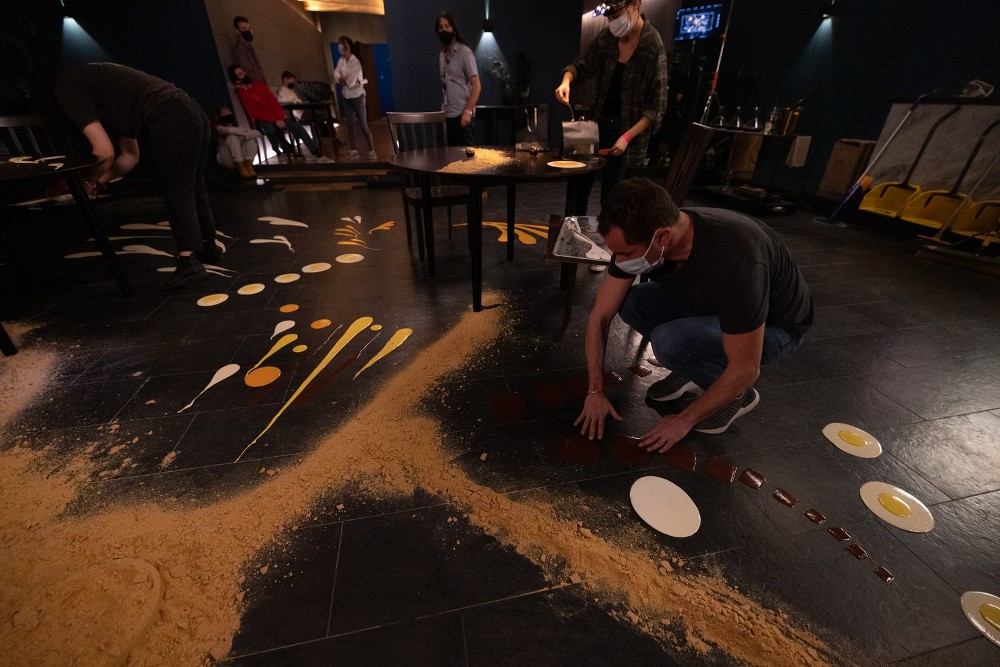
BTL: The last time we spoke, we were in the midst of COVID, and you worked right through it. Have you found that it’s gotten any easier to do what you do? Have the on-set restrictions eased up a bit?
Tobman: Easier in terms of the volume of work, or easier in terms of its execution?
BTL: I guess more about doing the work that you need to do with all the people you need to work with.
Tobman: Yeah, good question. I am really grateful, and I have a really special experience because I do equal parts movies, commercials, TV, and music videos. I work very closely with Taylor Swift –– we’ve done a lot of projects together. I have not had much of a day off this year. It’s been a very full, very awesome, but very, very dense period of creativity. And I also did Madame Web, my first superhero film for Sony. That just wrapped, and I just did those Taylor Swift videos that just came out from Midnights. I try to stay really busy by trying to stay nimble; I do really different things, and I always will. I’m never going to want to only do one type of thing. That keeps me very busy. My friends, who exclusively do commercials or just music videos or just movies, have told me there is quite a slowdown, and it’s been hard for them, especially with the downturn of the economy. This is the time of year [when] you see a lot of things going into production… and they’re not.
BTL: I’m surprised because I’d think that production would be picking up right now with so many streamers.
Tobman: I think it’s a mixture — things always slow down in an election year. Things always slow down when the economy takes a sudden downturn. COVID makes things really expensive, and the pipeline results of that are still hugely inflated. On top of that, Netflix posted really bad earnings, and TV is really… not grinding to a halt, but it’s slowing down. That crazy streaming war rush to production is correcting itself, much [in] the way the real estate market does. I think we’re seeing a correction of several industries at the same time. I think it’s really unpredictable and slower than it should be.
BTL: Did you have to design 12 different videos for Midnights?
Tobman: There are two music videos that have been released and that have been made. All I know about is the two that have come out, and I just love the album so much. I think it’s my favorite Taylor Swift album, for sure.
The Menu is now playing in theaters nationwide, and you can click here to read our interview with Director Mark Mylod on Above the Line.





